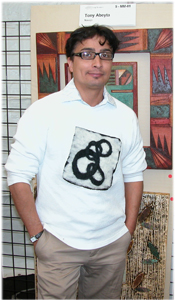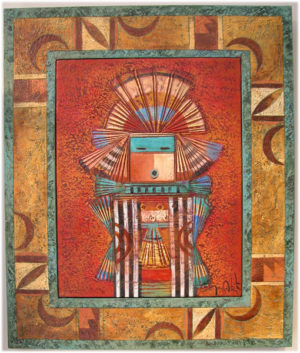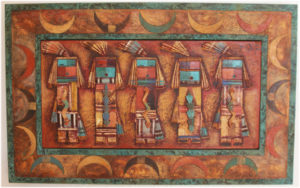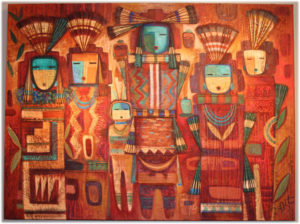Tony Abeyta

When Tony Abeyta’s father, Narciso, a renowned traditional Navajo painter, sold a painting 25 years ago, the most he could get was $100 to $200. To make a living, he worked full-time as an interpreter for the state of New Mexico. He painted on weekends.
Today, Tony makes a living from his artwork, which also deals in American Indian images. Early recognition has allowed him to devote his time to what he loves best. Young Abeyta is an excellent example of the contemporary Southwestern Indian artists whose struggles for success have differed dramatically from predecessors’.
Educated at Santa Fe’s Institute of American Indian Art, the Maryland Institute’s College of Art in Baltimore, and then overseas in Southern France and Florence, Italy, Abeyta, a graduate of the Maryland Institute, returned to school taking postgraduate classes in art and filmmaking at the Chicago Art Institute on a Ford Foundation scholarship.
Abeyta uses the bold colors representative of his homeland and finds his medium of painting involving sand, acrylic and oil paint, gold leafing and encaustic wax and collage elements to achieve the desired results of his work. “I use many different techniques, mediums and processes to reinforce my ideas.”
“Although I have studied sculpture, drawing and printmaking I choose painting as my means of translating these ideas as well as my spiritual self onto the canvas.”
Working with vast fields of color and texture one might find Indian crosses, early Navajo blanket designs, as well as prehistoric sensibilities of Indian design and earth toned color. Abeyta’s early work focused on Native American deities such as the Navajo Yei-be-chai and Kachinas. He shows the importance of these images in Native American religion and culture without literally depicting them.
“I want my work to reinforce the ideology of Indian religion, its strength, its beauty and semblance. I work to create an interpretation of these deities translated through myself and given an identity devoid of their actual documented existence. I’m more interested in an icon or the idea, which these beings represent. This system of ritual belief is the most important basis in Indian culture and insures its infinite existence.”
More recently, Tony’s work has focused on the emotional experience one finds in the New Mexico landscape. Tony attempts to capture the rhythm of nature in his paintings. Depicting the light, the cascades of mesas into canyons, and the marriage between earth and sky.
Showing all 3 results, including child brands



